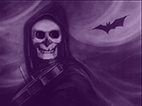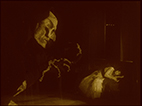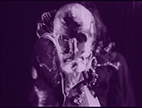Danse Macabre - Dudley Murphy
- Unseen Cinema Collection |
- 1922 |
- 9 minutes |
- COLOR/B&W |
- SOUND
Rental Format(s): Digital File
Co-makers: Dudley Murphy and Adolph Bolm
Assisted by Francis Bruigière, F.A.A. Dahme
Production: Visual Symphony Production, Inc.
Original format: 35mm silent film 1.33:1
Idea and Choreography: Adolph Bohm
Lighting: Francis Bruguière;
Featuring Adolph Bolm, Ruth Page, and Olin Howland
Music: Camille Saint-Säens
Performed by City of Birmingham Symphony Orchestra
Courtesy: George Eastman Museum
Murphy's conception of a cinematic symphony first realized in his The Soul of the Cypress (1920) is furthered with this short dance film conceived and performed by dancer Adolph Bolm in collaboration with Ruth Page. Murphy makes original contributions through his depiction of the devil via superimposition and extensive use of animation to begin the film. The mood is stylishly enhanced by Francis Bruguière's dramatic lighting effects and the powerful use of color tints and tones. The coup de grace is the synchronization of the dance to Saint-Säens' music. The film represents a successful early attempt to coordinate music, dance and lighting into a pure aesthetic experience, hence the descriptive nomenclature Visual Symphony. -Bruce Posner
Adolph Bolm, a Russian-born American ballet dancer and choreographer, studied at Saint Petersburg's Imperial Ballet School and danced in its affiliated company. Artistically restive, he partnered Anna Pavlova on her first European tours, in 1909 joined Diaghilev's Ballets Russes, and in 1917 settled in the United States, where his choreographic career blossomed. He died in Hollywood, California.
Boston-born Dudley Murphy was an engineering student, World War I pilot, and movie set decorator before launching his directing career with a series of evocative short films including the first American avant-garde film to be screened in New York City, The Song of the Cypress (1921). These musically driven experiments culminated in the jazz-infused Ballet Mecanique, and influenced his later Hollywood and independent features, including The Emperor Jones (1933). -Susan Delson
San Francisco photographer Francis Bruguière came to London with one completed film Danse Macabre (1922) made with Dudley Murphy and one unfinished personal project The Way (1925). Bruguiére pioneered abstract lighting effects to evoke dramatic modes of expression. He also collaborated with Norman Bel Geddes on a "pseudomorphic film" that was abandoned. -David Curtis/Bruce Posner








